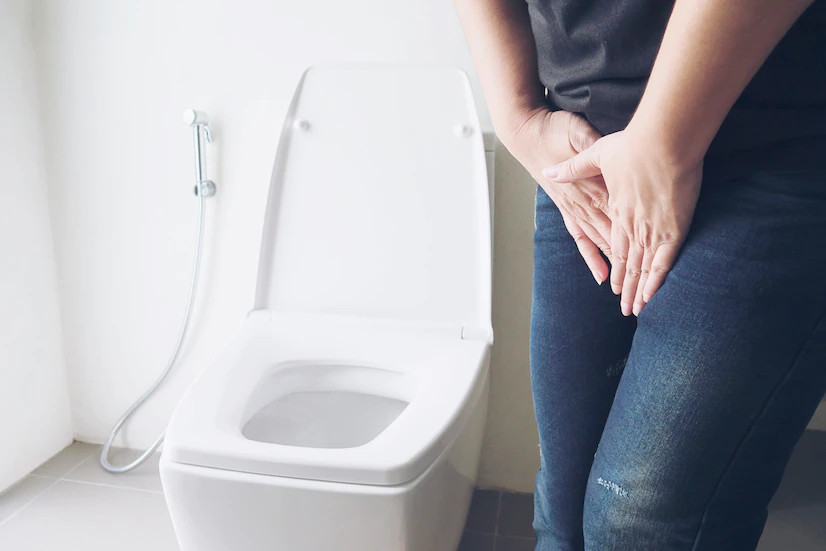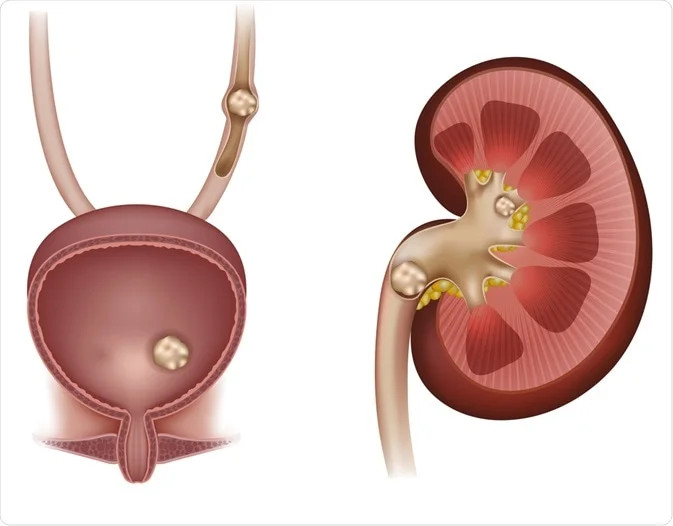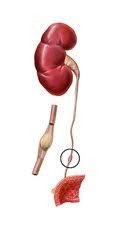Definisi
Infeksi saluran kemih atau ISK merupakan infeksi yang terjadi pada sistem perkemihan atau organ dan saluran kencing, yang meliputi organ ginjal, saluran ureter, kandung kemih atau kantung kencing, dan saluran uretra. Kasus infeksi saluran kemih paling sering dijumpai terjadi pada saluran bagian bawah yaitu, kandung kemih (sistitis) dan uretra (uretritis). Infeksi saluran kemih lebih banyak terjadi pada perempuan. 50% perempuan pasti pernah mengalami 1 kali infeksi ini di sepanjang hidupnya. Meski begitu, laki-laki juga bisa mengalami infeksi saluran kemih, dan sekitar 1 dari 10 laki-laki akan mengalami ISK sepanjang hidup mereka.
Penyebab
Infeksi saluran kemih terjadi ketika ada bakteri yang masuk ke sistem perkemihan dan menyebabkan infeksi. Bakteri tersebut masuk melalui saluran uretra dan dapat berkembang dimana saja. Saluran uretra merupakan saluran yang mengalirkan urine dari kandung kemih keluar dari tubuh. Jenis bakteri yang bisa menginfeksi saluran kemih adalah bakteri E. coli, bakteri yang sering ditemukan di saluran cerna. Bakteri ini berpindah tempat ke uretra dan menembus pertahanan tubuh. Infeksi terjadi ketika bakteri tersebut berkembang biak melebihi jumlah normal seharusnya di tubuh. Perpindahan bakteri ini disebabkan oleh beberapa hal seperti cara membersihkan area kemaluan yang kurang tepat, hubungan seksual, dan faktor lainnya.
Faktor Risiko
Infeksi saluran kemih paling sering terjadi pada perempuan dibandingkan laki-laki. Faktor-faktor yang dapat meningkatkan risiko perempuan mengalami ISK antara lain:
- Anatomi saluran kemih perempuan. Lokasi uretra perempuan berada dekat dengan vagina dan anus, serta uretra perempuan juga berukuran lebih pendek dibandingkan laki-laki. Hal ini mempermudah bakteri untuk berpindah tempat ke saluran kemih.
- Aktivitas seksual yang tinggi.
- Faktor risiko ini berkaitan dengan sirkulasi hormon estrogen yang menyebabkan saluran kemih lebih rentan infeksi.
- Penggunaan metode KB khusus. Seperti diafragma dan kondom tanpa lubrikan.
- Perubahan hormon dan fisiologis yang terjadi pada kehamilan.
- Membiarkan area genital lembap dan tidak bersih.
Faktor risiko yang tidak spesifik lainnya adalah:
- Bentuk saluran kemih yang tidak normal.
- Adanya sumbatan di saluran kemih yang membuat aliran urine tidak lancar, seperti batu ginjal atau pembesaran kelenjar prostat yang menekan kandung kemih.
- Penurunan sistem imun yang biasanya terjadi pada penderita diabetes atau pasien yang sedang menjalani kemoterapi.
- Penggunaan kateter urine yang lama pada pasien rawat inap, pasien gangguan saraf, atau kondisi lain yang membutuhkan penggunaan alat bantu ini.
- Prosedur pembedahan yang dilakukan pada sistem perkemihan.
- Adanya infeksi menular seksual.
- Kebiasaan kurang minum air putih.
Gejala
Gejala dari infeksi saluran kemih muncul karena adanya iritasi di organ yang terinfeksi. Beberapa gejala yang bisa muncul di antaranya:
- Rasa ingin berkemih yang kuat.
- Nyeri atau sensasi terbakar saat buang air kecil.
- Nyeri pada perut bagian bawah atau pinggang belakang.
- Frekuensi buang air kecil meningkat namun urine yang dapat dikeluarkan hanya sedikit.
- Warna urine berubah, dapat terlihat keruh, berwarna merah, pink, atau kecoklatan.
- Bau menyengat pada urine.
- Demam atau meriang yang menandakan infeksi sudah naik ke ginjal.
Diagnosis
Diagnosis dapat ditegakkan dari gejala dan pemeriksaan yang dilakukan dokter. Pemeriksaan yang dapat dilakukan berupa:
1. Tes urine atau urinalisis
Pemeriksaan urine dilakukan di laboratorium dan akan dilakukan analisis untuk melihat adanya sel darah merah, sel darah putih, ataupun bakteri. Sebelum sampel diambil, bersihkan dahulu area genital dengan kain antiseptik, lalu ambil sampel dari urine pancaran tengah.
2. Kultur urine
Tujuan dari pemeriksaan ini adalah untuk melihat bila ada pertumbuhan bakteri dari sampel urine yang diambil. Bakteri yang tumbuh akan diidentifikasi jenisnya sehingga pengobatan antibiotik yang diberikan sesuai.
3. Pemeriksaan pencitraan
Pemeriksaan pencitraan yang bisa dilakukan adalah USG, CT scan, atau MRI. Pemeriksaan ini biasanya dilakukan untuk infeksi saluran kemih berulang, berguna untuk memastikan apakah infeksi sudah naik ke ginjal atau belum. Selain itu, pemeriksaan juga bertujuan untuk melihat bentuk anatomis dari saluran kemih. Pemeriksaan lain yang bisa dilakukan juga adalah sistoskopi. Pemeriksaan ini menggunakan selang panjang dan tipis yang terpasang kamera, dimasukkan melalui uretra untuk melihat saluran uretra dan kandung kemih. Pemeriksaan ini tidak terlalu nyaman bagi pasien, dan dilakukan hanya pada beberapa kasus infeksi saluran kemih berulang.
Tata Laksana
Infeksi saluran kemih biasanya membutuhkan obat antibiotik. Antibiotik ini berfungsi untuk membunuh bakteri yang menginfeksi dan harus diresepkan oleh dokter. Penggunaan antibiotik juga harus sesuai dengan anjuran dokter agar dapat bekerja efektif. Antibiotik harus tetap dikonsumsi hingga habis walaupun gejala sudah berkurang.
Bila ada keluhan nyeri atau rasa panas saat buang air kecil, dokter akan memberikan obat untuk mengurangi nyeri tersebut. Dokter bisa memberikan obat antinyeri seperti parasetamol. Keluhan nyeri yang dirasakan di bagian perut dapat dikurangi dengan penggunaan handuk atau kain hangat, bisa ditempelkan di bagian perut. Hal ini dapat mengurangi rasa tidak nyaman dan mengurangi tekanan pada kandung kemih. Selain penggunaan obat, Anda harus minum lebih banyak air untuk mendilusi urine.
Bila infeksi saluran kemih muncul kembali setelah pengobatan, dokter dapat memberikan antibiotik dosis rendah yang dikonsumsi dengan jangka waktu lebih lama. Dokter umum juga dapat merujuk Anda ke dokter spesialis urologi apabila infeksi saluran kemih terjadi 3 kali atau lebih dalam 1 tahun.
Komplikasi
Komplikasi biasanya jarang terjadi pada infeksi saluran kemih bawah. Tapi kondisi penyakit yang berulang dan penanganan yang kurang tepat dapat memberikan komplikasi serius. Komplikasi tersebut meliputi :
- Infeksi saluran kemih kronik. Biasanya pada perempuan yang mengalami 2 atau lebih kejadian infeksi saluran kemih dalam 1 tahun.
- Kerusakan ginjal permanen.
- Meningkatkan risiko kelahiran prematur pada ibu hamil dan berat badan lahir rendah pada janin.
- Penyempitan saluran uretra pada laki-laki.
- Sepsis atau infeksi berat, terutama bila infeksi sudah mencapai ginjal.
Pencegahan
Pencegahan dapat dimulai sejak dini. Berikut beberapa cara pencegahan yang efektif, yaitu:
- Konsumsi air putih yang cukup.
- Kurangi konsumsi kopi, alkohol, dan minuman bersoda yang mengandung jus jeruk. Jenis minuman ini dapat mengiritasi kandung kemih dan memperparah peradangan.
- Bersihkan area genital dari arah depan ke belakang, bukan sebaliknya. Hal ini untuk mencegah perpindahan bakteri dari anus atau vagina ke uretra.
- Buang air kecil setelah berhubungan seksual dan bersihkan area genital.
- Jangan menahan buang air kecil.
- Hindari penggunaan produk untuk organ intim yang berpotensi untuk mengiritasi area genital, seperti produk yang memiliki pewangi.
- Pilih metode KB selain kontrasepsi diafragma atau kondom tanpa pelumas.
- Gunakan celana dalam berbahan katun untuk mencegah lembap dan ganti celana dalam ketika basah. Hindari penggunaan celana yang ketat. Kondisi lembap akan mempercepat pertumbuhan bakteri.
Kapan Harus ke Dokter?
Bila Anda mengalami gejala infeksi saluran kemih, segeralah berobat ke dokter di layanan kesehatan terdekat. Penyakit ini harus ditangani dengan tepat sehingga risiko terjadinya infeksi berulang dan komplikasi lainnya bisa berkurang. Beberapa tanda bahaya yang harus diwaspadai adalah:
- Demam dengan suhu yang sangat tinggi hingga menggigil
- Suhu tubuh turun di bawah 36oC
- Penurunan kesadaran
- Tidak buang air kecil sepanjang hari
- Nyeri yang memberat di perut bagian bawah atau pinggang belakang
- Urine terlihat berdarah
Bila ada salah satu tanda bahaya di atas, segeralah berobat ke dokter agar Anda bisa cepat ditangani.
Mau tahu informasi seputar penyakit lainnya? Cek di sini, ya!
- dr Hanifa Rahma
Urinary tract infection (UTI) - Symptoms and causes. Mayo Clinic. (2022). Retrieved 14 June 2022, from https://www.mayoclinic.org/diseases-conditions/urinary-tract-infection/symptoms-causes/syc-20353447.
Urinary Tract Infection (UTI). WebMD. (2022). Retrieved 14 June 2022, from https://www.webmd.com/women/guide/your-guide-urinary-tract-infections.
Urinary tract infections (UTIs). nhs.uk. (2022). Retrieved 16 June 2022, from https://www.nhs.uk/conditions/urinary-tract-infections-utis/.












